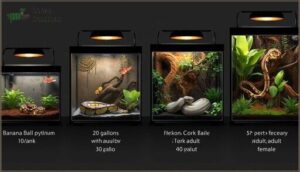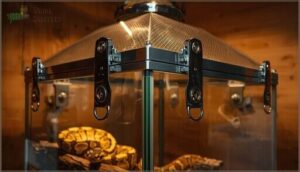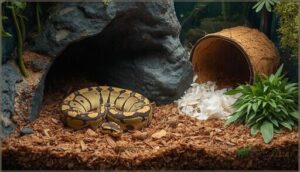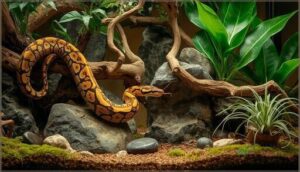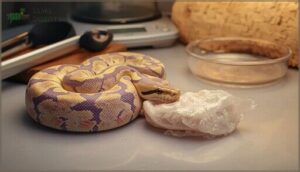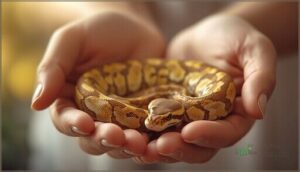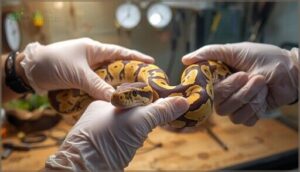This site is supported by our readers. We may earn a commission, at no cost to you, if you purchase through links.
When I first examined a three-year-old banana ball python in my clinic, its owner was stunned by how different it looked from the bright yellow hatchling she’d brought home. That gradual freckle development caught her completely off guard—and it’s one of many surprises new keepers face with this stunning morph.
Banana ball pythons combine show-stopping colors with the species’ famously docile temperament, making them irresistible to beginners and collectors alike. But their beauty won’t compensate for a poorly designed habitat or inconsistent care routine.
Your snake’s long-term health depends on getting the fundamentals right from day one: proper enclosure setup, stable temperature and humidity zones, and a feeding schedule that matches your python’s life stage. Master these banana ball python care tips, and you’ll set the stage for decades of rewarding companionship with one of the hobby’s most photogenic snakes.
Table Of Contents
- Key Takeaways
- Banana Ball Python Characteristics
- Setting Up The Ideal Enclosure
- Maintaining Proper Temperature and Humidity
- Feeding and Nutrition Tips
- Safe Handling and Socialization
- Preventing and Managing Health Issues
- Frequently Asked Questions (FAQs)
- How to care for ball python for beginners?
- What not to do with a ball python?
- How often should a banana ball python eat?
- How often should you soak a ball python?
- How often should I clean the enclosure?
- Can I house multiple banana ball pythons together?
- What are the signs of a healthy snake?
- How do I know if my snake is shedding?
- Can I feed my snake other types of prey?
- How often do banana ball pythons shed?
- Conclusion
Key Takeaways
- Your banana ball python’s vibrant yellow coloring will develop distinctive dark freckles over its first few years, a natural progression that many new owners don’t expect but shouldn’t worry about.
- Creating the right environment means maintaining a temperature gradient of 78–88°F with a 90°F basking spot, plus 50–60% humidity that bumps to 70–80% during shedding—these aren’t suggestions, they’re requirements for proper digestion and skin health.
- Feed hatchlings weekly with prey sized at 10–15% of body weight, then gradually space out meals as your snake matures until adults eat every 2–3 weeks, always using frozen-thawed rodents to avoid injury risks.
- Regular handling builds trust, but skip the first 7–14 days after bringing your snake home and always wait 24–72 hours after feeding to prevent regurgitation and stress.
Banana Ball Python Characteristics
Before you bring home a banana ball python, you’ll want to know what makes this morph stand out from the crowd. These snakes have a look and personality that’s all their own, and understanding their traits helps you provide better care.
Let’s break down the key characteristics that define the banana ball python.
Visual Traits and Color Morph
The banana ball python morph catches your eye instantly with its golden-yellow ground color layered over a soft tan or lavender base—a striking shift from the dark brown found in wild-type snakes. This color intensity comes from a genetic mutation that reduces dark pigment and boosts yellow tones, and researchers have linked similar changes in ball python morphs to variations in genes like MC1R that control pigment-cell signaling. Recent research highlights the role of MC1R in pigmentation in ball pythons.
- Freckle development: Hatchlings start with few spots, but over the first few years, dark purplish “freckles” accumulate along the body, creating a distinctive speckled adult look.
- Genetic basis: The banana trait is heritable and stable, allowing you to pair it with other morphs—like pied or clown—to create stunning combo morphs with layered patterns.
- UV perception: Ball pythons see ultraviolet light through specialized cone cells, so the high-contrast yellow and freckled pattern is visually salient to them, not just to us.
- Color intensity: Under indoor lighting, the bright yellow patches bordered by pale outlines make banana ball python morphs some of the most eye-catching snakes in captivity.
Size, Lifespan, and Temperament
Beyond their stunning appearance, banana ball pythons mature to predictable adult sizes that suit most homes. Males average 2.5 to 3.5 feet, while females reach 3 to 5 feet—remarkably manageable for a python. Growth patterns peak in the first three years, then plateau.
With proper care, your captive lifespan can hit 20 to 30 years, far outlasting the 10-year wild average. Their docile temperament shines through calm body language, though stress indicators like tight coiling signal when your snake needs space.
An important aspect of their well-being is providing a good hide box to reduce stress.
Differences From Other Ball Python Morphs
While many morphs share ball python characteristics, the banana stands apart through unique genetic mutations. This codominant morph produces visible offspring in first-generation crosses—unlike recessive traits that hide for generations.
You’ll notice striking visual pattern differences: bright yellows with lavender tones that develop freckles over time.
Market availability soared after banana ball python morphs dropped from $25,000 to under $200, yet health considerations remain minimal compared to neurological-risk morphs like spider.
Setting Up The Ideal Enclosure
Your banana ball python’s enclosure isn’t just a cage—it’s their entire world, and getting it right makes all the difference in their health and happiness.
From choosing the right tank size as they grow to picking substrates that hold humidity without harboring bacteria, each decision shapes their comfort and your peace of mind.
Let’s walk through the essentials so you can create a safe, secure home your snake will thrive in for years to come.
Recommended Tank Size by Age
Your snake’s age and size dictate how much room they need to thrive. Hatchlings weighing 50–80 grams fit comfortably in 10-gallon enclosures, while juveniles around 6–12 months benefit from 20–40-gallon tank upgrades as they grow. Subadult habitat needs expand to 40 gallons by year one, and adult male enclosures should offer at least 36 × 18 inches of floor space. Breeding female tanks often require 55–75 gallons to accommodate their larger frames—think of it as giving them room to stretch and regulate their body temperature naturally.
- Hatchling enclosure size: 10 gallons for snakes under 300 grams
- Juvenile setup: 20–40 gallons as they reach 1.5–2 feet
- Adult space: 40+ gallons with long floor dimensions
- Large females: 55–75 gallons for maximum comfort
Secure and Escape-Proof Design
When your ball python’s enclosure lacks proper lid locking and material integrity, you’re inviting an escape artist into your home. Snake enclosure setup demands metal clamps on all four lid corners—because pythons wedge through millimeter-sized gaps at unsecured edges.
Drill ventilation security holes smaller than your snake’s head, arrange interior barriers away from doors, and run weekly husbandry checks on latches. Your ideal habitat for ball pythons should treat every opening like a vault.
Best Substrates and Hides
Your substrate choice defines humidity performance and substrate safety. Cypress mulch holds 65%+ moisture naturally, coconut husk balances absorption with low dust, while paper products dry out fast.
Provide three hiding spots minimum: one warm-side, one cool-side, and a humid hide filled with damp moss for shedding support. Tight-fitting, non-porous hides beat oversized options for security, and weekly hide maintenance prevents bacterial buildup in your habitat.
Enrichment and Decor Options
Beyond hiding spots, enrichment transforms your habitat setup into a genuinely stimulating space. Climbing structures, branches at multiple heights, and naturalistic decor like plants encourage exploration and vertical activity—studies show enriched snakes develop 7–9% greater brain volume than those in barren tanks.
Enriched habitats with climbing structures boost snake brain volume by 7–9% compared to barren enclosures
Add sensory enrichment through varied textures, rotate decor monthly for cognitive tasks, and watch your python engage with environmental stimuli naturally.
Maintaining Proper Temperature and Humidity
Getting the temperature and humidity right isn’t just about comfort—it’s about keeping your banana ball python healthy, digesting properly, and shedding like a champ. These snakes rely on you to create the warm-to-cool gradient they’d naturally seek out in the wild, along with just enough moisture in the air.
Let’s break down exactly how to nail these critical environmental factors.
Creating a Temperature Gradient
Your banana ball python can’t tell you when it’s too hot or too cold—it simply moves to find the right spot, so habitat setup with proper temperature gradients is everything. Thermoregulation depends on reliable heat sources, thermostat settings, and gradient control you create through careful temperature monitoring and temperature lighting.
- Set your warm side to 85–88°F ambient air and a basking surface around 90°F for thermal regulation.
- Keep the cool side steady at 78–80°F so your snake can choose comfort zones.
- Use overhead radiant heat like ceramic emitters for ambient warmth rather than just under-tank pads.
- Place your thermostat probe inside the warm hide at snake level to control actual hotspot temperature.
- Check with an infrared temp gun daily across all surfaces—creating ideal temperature gradients means verifying every zone stays safe and never exceeds 95°F.
Humidity Levels for Health and Shedding
Humidity levels are crucial in ensuring a clean, one-piece shed for your ball python, preventing hours-long soaking sessions. Maintaining a baseline humidity of 50–60% is essential for daily reptile care and respiratory health. During the shedding process, increase humidity to 70–80% for those few days, then revert to the normal range. Prolonged exposure to low humidity can lead to stuck eyecaps and dehydration, while sustained high humidity may cause scale rot and respiratory issues.
| Humidity Range | When to Use | Purpose |
|---|---|---|
| 50–60% | Daily maintenance | Prevents dehydration and aids skin health |
| 70–80% | Active shedding cycle | Softens retained skin for complete, single-piece shed |
| Below 50% or above 80% | Avoid prolonged exposure | Reduces risk of incomplete sheds or bacterial infections |
To manage humidity effectively, consider using moisture-retentive substrates like coconut husk, placing a large water bowl over the warm side for evaporation, or creating a humid hide with damp sphagnum moss. Mist surfaces as needed, and always verify humidity levels with a hygrometer. Remember, temperature and humidity control work together to ensure your ball python thrives.
Monitoring Tools and Equipment
You can’t control what you don’t measure, so equip yourself with reliable tools. Use probe thermostats to prevent dangerous temperature spikes, and pair them with digital hygrometers to track humidity.
Smart monitoring systems send alerts when conditions drift, while backup monitoring devices keep watch during power outages.
Sensor accuracy matters—calibrate regularly to make certain temperature and humidity management stays on point, maintaining proper humidity for stress-free sheds and healthy respiration.
Heating and Lighting Tips
Once your monitoring tools are in place, heat sources do the heavy lifting. Choose incandescent or halogen bulbs for daytime basking surfaces around 90°F, paired with ceramic emitters for nighttime warmth.
Always wire each heat source through a thermostat to prevent burns, and add UVB lighting across one-third of the enclosure to support calcium metabolism.
This gradient layout lets your snake thermoregulate naturally, balancing temperature and humidity control for year-round health.
Feeding and Nutrition Tips
Getting your banana ball python’s diet right is one of the most important parts of keeping them healthy and thriving. You’ll want to know what size prey to offer, how often to feed, and how to handle frozen rodents safely.
Let’s walk through the key nutrition tips that will help your snake digest meals properly and avoid common feeding problems.
Choosing Appropriate Prey Size
Getting the prey size just right keeps your banana ball python healthy and thriving. Follow these feeding guidelines to match prey weight ratio and snake body width at every age growth stage:
- Hatchlings need prey around 10-15% of their body weight weekly
- Juveniles should receive similarly sized meals every 7-10 days
- Adults do well with 5-10% of body weight every 2-3 weeks
- Each food item shouldn’t exceed 1.5 times your snake’s widest point
- Choose frozen prey quality over live to minimize feeding stress impact
Monitor your snake’s body condition regularly, adjusting diet portions as needed to prevent obesity or underfeeding.
Feeding Frequency and Schedule
Once you’ve nailed prey size, feeding frequency becomes your next priority. Young banana ball pythons under 200 grams thrive on weekly meals, while juveniles gradually shift to 7–14 day age-based intervals as they grow. Adults over 1500 grams often do well with food every 4–6 weeks, following their slower metabolism.
Don’t panic if your snake refuses meals seasonally—wild pythons naturally fast during breeding periods, showing seasonal variation is normal.
Safe Thawing and Feeding Practices
Now that you’re feeding regularly, proper thawing becomes non-negotiable for your snake’s safety. Always defrost frozen rodents in the refrigerator for 12–24 hours—never on the counter, where bacteria multiply fast.
Then warm prey in hot water to about 98–100°F, matching natural body heat. Use feeding tongs to offer meals, protecting your hands while preventing mix-ups.
Discard any refused rodents within two hours, and wash thoroughly afterward to avoid Salmonella exposure.
Recognizing Digestive Issues
Despite regular feeding, your snake’s digestive tract can still signal trouble. Watch for regurgitation signs—undigested meals appearing hours later—or prolonged appetite changes that stretch beyond routine fasting.
Fecal abnormalities like mucus, blood, or absence beyond six weeks raise red flags for impaction risks or parasites. Cloacal swelling paired with straining demands immediate veterinary care, as banana ball python care hinges on catching health issues early.
Safe Handling and Socialization
Getting comfortable with your banana ball python takes patience, but these snakes are naturally calm and forgiving with proper technique. Whether you’re handling your snake for the first time or teaching a child how to interact safely, a few simple guidelines will keep both of you relaxed and confident.
Let’s walk through the essentials of building trust, recognizing when your snake needs space, and maintaining good hygiene habits.
Building Trust With Your Snake
Trust doesn’t happen overnight with your banana ball python—patience is your best friend here. During the initial acclimation period of 7–14 days, resist the urge to handle your new snake. Let it settle in, eat that first meal, and adjust to its surroundings.
Once acclimated, follow these handling frequency guidelines to build confidence:
- Handle 1–3 times per week to avoid chronic stress while maintaining regular contact
- Keep sessions short at 10–20 minutes, reading cues like tight coiling or hiding behavior
- Skip handling for 24–72 hours after feeding to prevent regurgitation and support healthy digestion
Enclosure security matters tremendously—snakes in well-designed setups with proper hides and consistent routines show calmer temperaments during socialization and handling. You’re creating a foundation for years of safe ball python handling ahead.
Handling Techniques for Adults and Kids
When handling your banana ball python, support at least one-third of its body length with both hands positioned beneath its center of mass. Avoid handling during shedding when your snake’s vision is impaired and sensitivity peaks.
Keep sessions under 10–20 minutes for adults, 5–10 minutes for kids, and always supervise children closely. Wash hands before and after every handling session to prevent Salmonella transmission.
Recognizing Signs of Stress
Your banana ball python will tell you when something’s wrong—you just need to recognize the signals. Behavioral changes like pacing along glass walls, defensive postures with an S-shaped neck, or constant hiding during normal active hours all point to stress.
Watch for these red flags:
- Feeding refusal over multiple scheduled meals despite proper setup
- Posture changes including tight balling during handling or head-hiding
- Activity pattern shifts like unusual daytime restlessness or complete lethargy
- Escape attempts with persistent nose rubbing at enclosure seams
Stress hormones rise quickly in response to environmental stimuli, so addressing these snake behavior cues promptly protects your python’s wellbeing and aids stress reduction.
Hygiene and Safety Precautions
You can’t see bacteria, but your ball python’s scales are covered in them—especially Salmonella. Thorough handwashing techniques with soap for at least 20 seconds after every reptile handling session form your first line of Salmonella prevention.
Preventive measures like separating snake care from human spaces protect everyone. If you notice skin irritation, unusual discharge, or breathing changes in your python, prompt veterinary care catches issues before they escalate into serious health crises.
| Safety Zone | Action Required |
|---|---|
| Kitchen & dining areas | Never thaw prey or wash equipment here—cross contamination spreads pathogens to food surfaces |
| Cleaning supplies | Use dedicated tools and disposable gloves for enclosure maintenance, discard after use |
| High-risk households | Keep pythons away from children under 5, pregnant individuals, or immunocompromised family members |
| Bite wounds | Immediately wash punctures with soap and water; seek veterinary care guidance for infection signs |
| Daily spot-cleaning | Remove waste promptly to reduce parasite loads and prevent respiratory infections from ammonia buildup |
Preventing and Managing Health Issues
Keeping your banana ball python healthy means staying one step ahead of potential problems. The good news is that most health issues are preventable with the right setup and regular observation.
Let’s walk through the most common concerns you’ll want to watch for and how to keep your snake thriving.
Common Health Problems in Banana Ball Pythons
Your banana ball python can face a few health hurdles. Respiratory infections rank as the most common problem, often triggered by cold temperatures or poor ventilation.
Skin infections, like scale rot, creep in when moisture lingers too long. Nutritional disorders—obesity from overfeeding or anorexia—also pop up.
Parasites and systemic infections round out the list of health considerations you’ll want to watch.
Signs of Illness to Watch For
Knowing what’s off helps you catch potential health issues early. Watch for respiratory distress—open-mouth breathing, wheezing, or nasal bubbles signal trouble. Oral abnormalities like red gums or cheese-like patches point to mouth rot.
Look for these red flags in your banana ball python health checks:
- Skin problems—ulcers, retained shed, or swollen scales
- Neuro changes—loss of balance or corkscrewing movements
- Appetite changes—refusing meals for weeks or noticeable weight loss
Preventative Care and Veterinary Visits
Catching problems early beats fixing them later, so preventative care for snakes is your best defense. Schedule wellness exams every 6–12 months with an exotic vet who understands snake health issues. These veterinary checkups include parasite screening, weight tracking, and a husbandry review of your setup. Planning ahead matters—especially for emergency preparedness, since some owners travel hours for care.
| Visit Component | What It Covers | Why It Matters |
|---|---|---|
| Physical Exam | Weight, body condition, activity level | Catches weight loss or subtle changes |
| Fecal Analysis | Microscopic check for internal parasites | Detects hidden infections early |
| Husbandry Review | Temperature, humidity, substrate check | Prevents respiratory infections and scale rot |
| Long-Term Planning | Age-related monitoring, chronic disease screening | Promotes 15–30 year lifespan |
Shedding Support and Hydration
Your snake’s shedding process depends on steady humidity levels and fresh water provision. Between sheds, keep humidity at 40–60%; bump it to 70% when her skin dulls and eyes turn blue.
Offer a sturdy water bowl big enough for soaking—it prevents shedding problems and aids natural rehydration methods. Add a humid hide with damp moss as one of the simplest support techniques you can use.
Frequently Asked Questions (FAQs)
How to care for ball python for beginners?
Your new ball python needs three things to thrive: a secure 40-gallon enclosure with proper hides, consistent temperatures between 78–95°F, and appropriately sized frozen-thawed rodents every 7–10 days.
What not to do with a ball python?
Never use tiny enclosures or skip cleaning—Enclosure Neglect leads to stress and illness. Avoid unregulated heat mats to prevent Thermal Burns.
Skip Live Feeding; it risks snake bites.
Stress Handling and Ignoring Symptoms delay recovery—schedule regular veterinary checkups.
How often should a banana ball python eat?
Feeding frequency depends on age: hatchlings eat every 5–7 days, juveniles every 7–10 days, and adults every 10–21 days.
Weight monitoring helps you adjust schedules, preventing obesity while supporting healthy growth throughout their lifespan.
How often should you soak a ball python?
You generally don’t need to soak your ball python routinely—once every two to four weeks is plenty for healthy snakes.
Reserve soaking for shedding problems or dehydration, and always prioritize proper humidity first.
How often should I clean the enclosure?
Your snake’s enclosure demands daily spot-cleaning like clockwork—remove waste and refresh water.
Weekly deep-cleans tackle substrate, habitat surfaces, and humidity control.
Monthly, sanitize everything to eliminate parasites and guarantee proper enclosure health with safe cleaning product-use.
Can I house multiple banana ball pythons together?
You shouldn’t keep multiple banana ball pythons together. Ball pythons are solitary by nature, and cohabitation risks include stress signs, feeding competition, and disease spread—even among calm banana morphs.
What are the signs of a healthy snake?
You’ll know your banana ball python is thriving when you see clear eyes, active tongue flicking, proper weight, normal breathing, and regular feeding—all key signs of reptile health and happiness that help prevent common snake health problems.
How do I know if my snake is shedding?
Like a curtain drawn before a performance, your ball python’s colors fade and its eyes cloud over with a milky blue film—unmistakable signs the shedding process has begun, requiring increased humidity for healthy skin removal.
Can I feed my snake other types of prey?
Yes, you can offer mice, African soft-furred rats, or day-old chicks to vary your ball python diet. Rats remain the best staple for balanced calcium and protein, while chicks work well as occasional treats.
How often do banana ball pythons shed?
Hatchlings shed roughly every 3 to 4 weeks—that’s up to 17 times a year! Adults generally shed every 4 to 8 weeks.
Proper humidity and nutrition keep the ball python shedding process smooth and complete.
Conclusion
Studies show that ball pythons kept in properly maintained enclosures live up to 30 years—triple the lifespan of those in substandard conditions. That’s the power of mastering banana ball python care tips from the start.
Your commitment to precise temperatures, consistent feeding, and vigilant health monitoring transforms a gorgeous morph into a thriving companion.
When you prioritize evidence-based husbandry over shortcuts, you’re not just keeping a snake—you’re ensuring decades of rewarding partnership with one of nature’s most fascinating reptiles.
- https://www.wilbanksreptiles.com/blogs/ideal-tank-size-for-healthy-ball-pythons/what-is-the-recommended-tank-size-for-a-ball-python
- https://inkbird.com/blogs/aquarium-terrarium/ball-python-enclosure-ideas-size-humidity-temperature
- https://reptifiles.com/ball-python-care-guide/ball-python-humidity-temperatures/
- https://www.jabberwockreptiles.com/news/ball-python-temperature/
- https://www.reddit.com/r/ballpython/comments/rila61/humidity/


